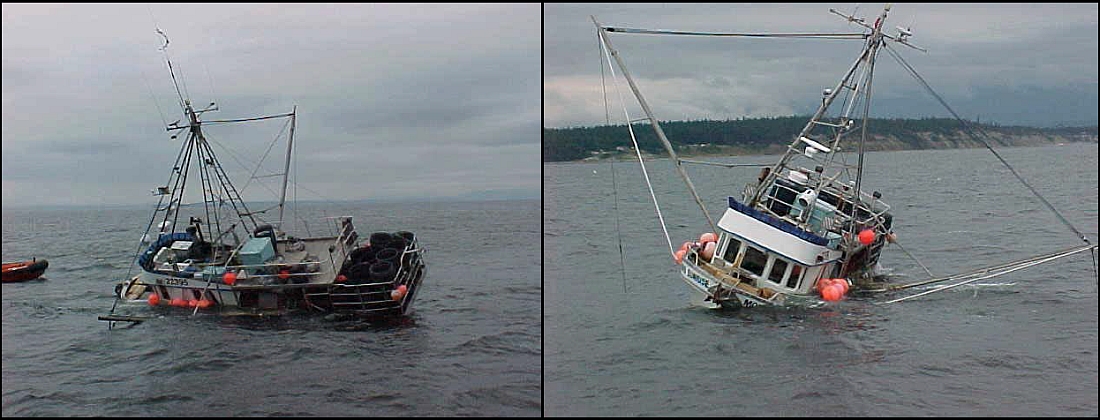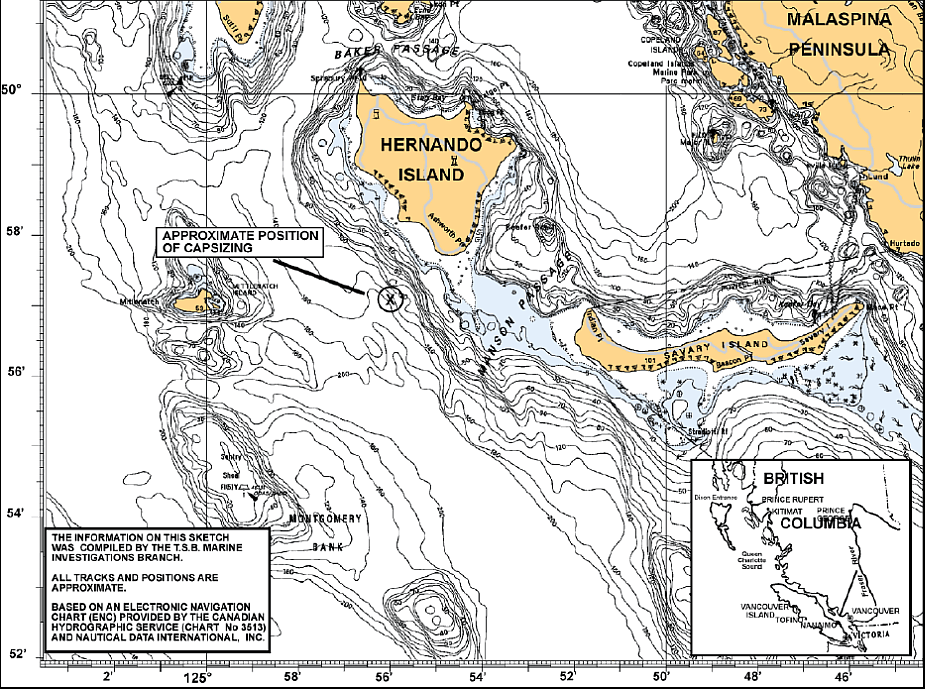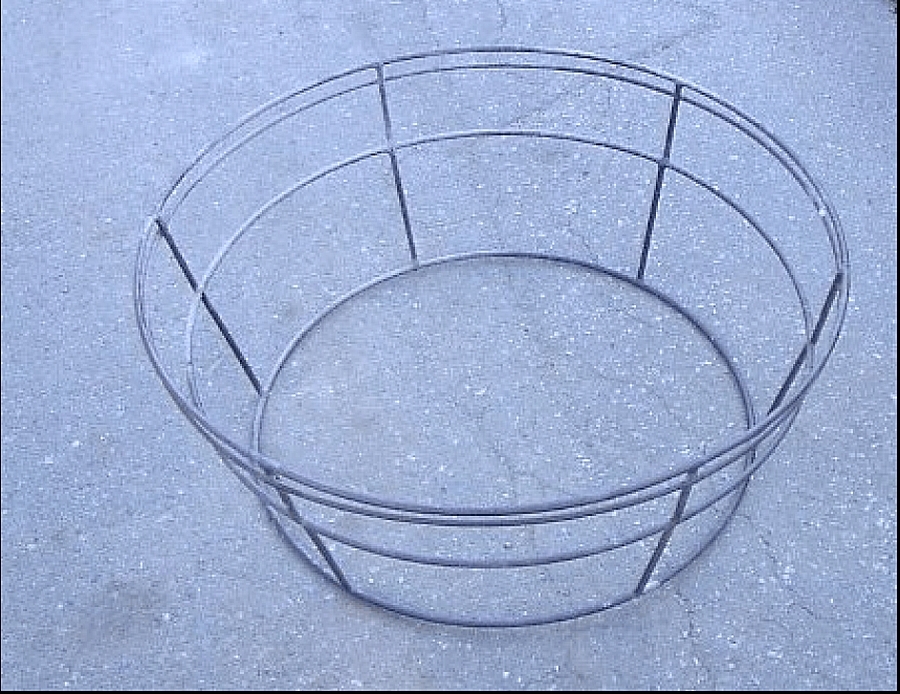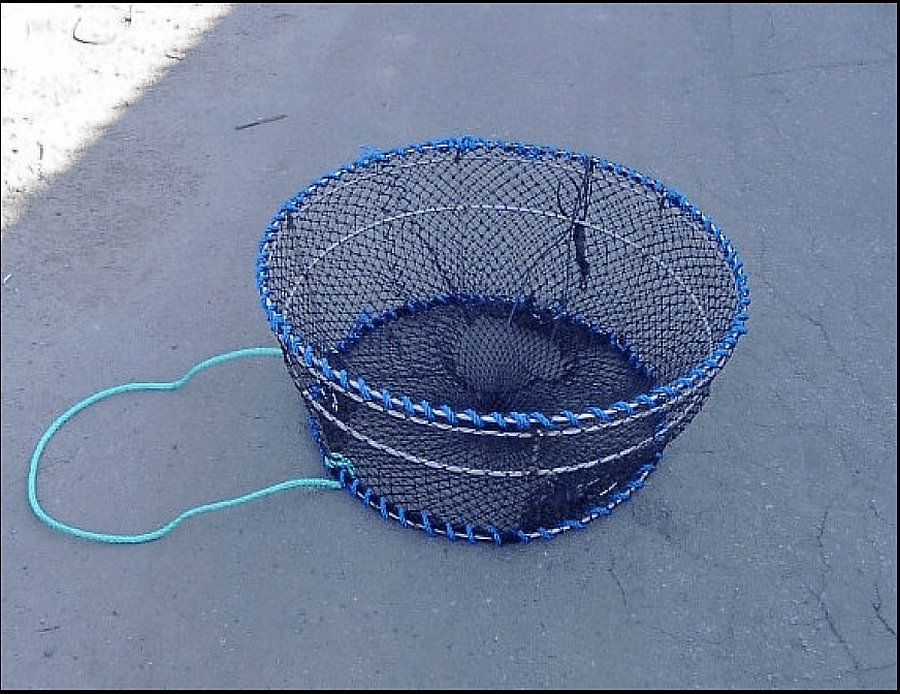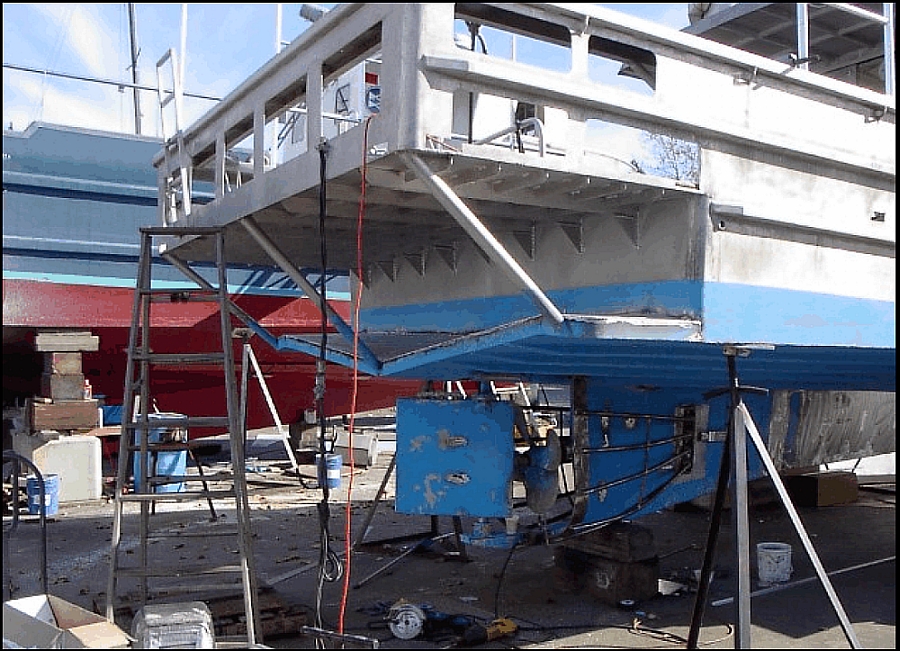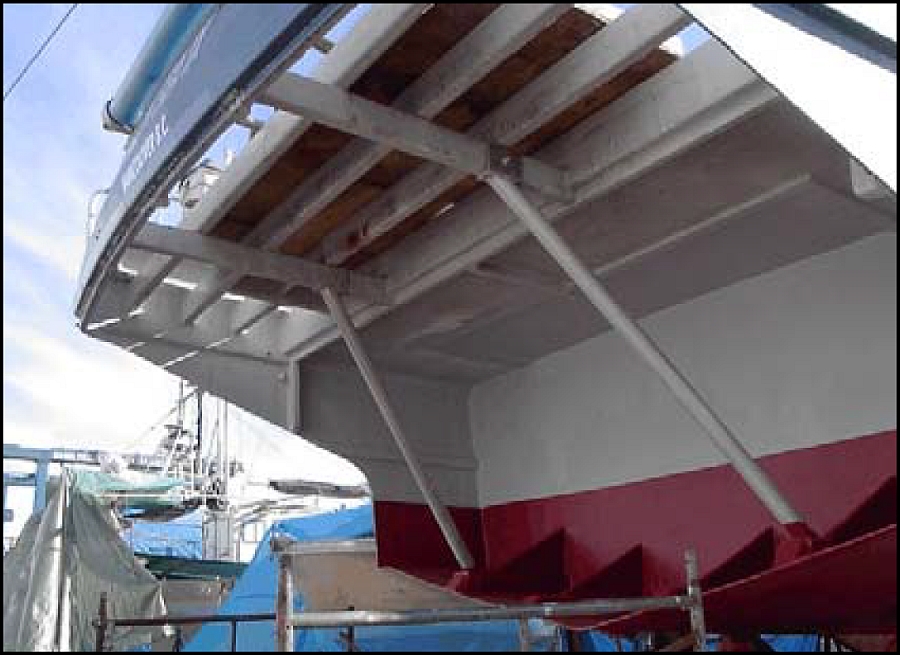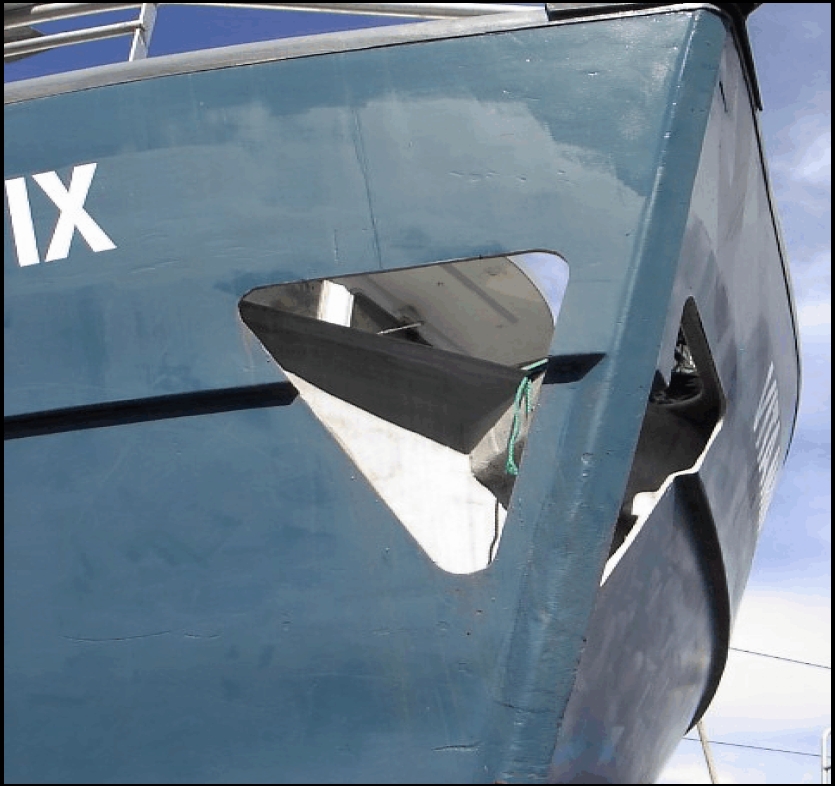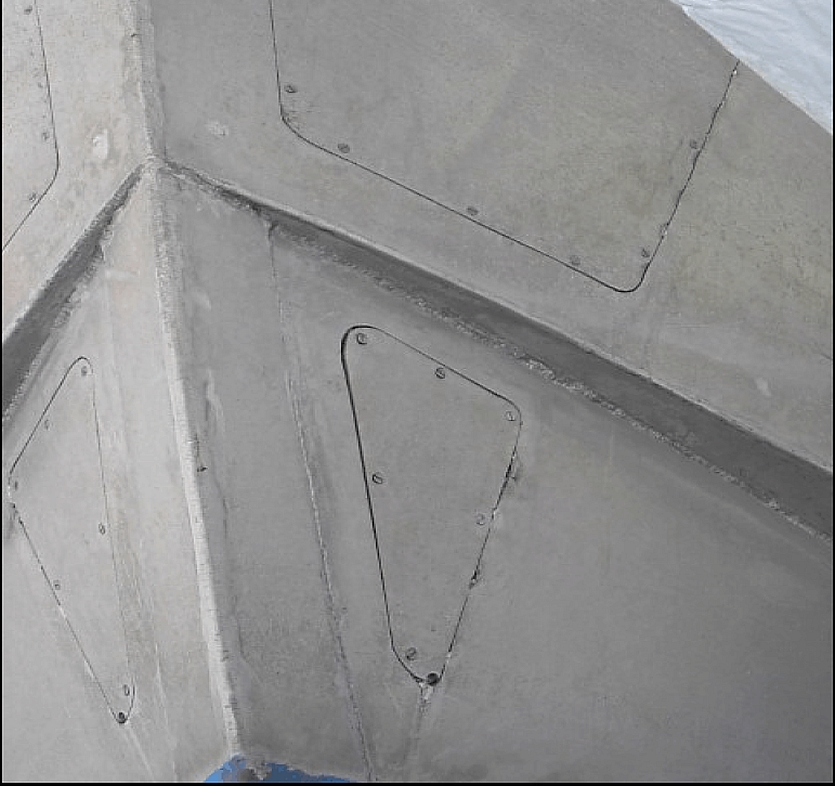Sinking
Fishing Vessel Morning Sunrise
off Savary Island,
Northern Georgia Strait, British Columbia
The Transportation Safety Board of Canada (TSB) investigated this occurrence for the purpose of advancing transportation safety. It is not the function of the Board to assign fault or determine civil or criminal liability. This report is not created for use in the context of legal, disciplinary or other proceedings. See Ownership and use of content. Masculine pronouns and position titles may be used to signify all genders to comply with the Canadian Transportation Accident Investigation and Safety Board Act (S.C. 1989, c. 3).
Summary
On 29 June 2005, at about 1640 Pacific daylight time, while en route from the Queen Charlotte Strait to Gibsons, British Columbia, on the Sunshine Coast, the small fishing vessel Morning Sunrise, with 500 prawn traps on deck and approximately 4500 kg of frozen prawns in boxes in the freezer hold, listed heavily to port and gradually sank in 152 m of water. All four crew members on board, wearing immersion suits, abandoned the vessel into a liferaft and were soon picked up by the Canadian Coast Guard cutter Cape Caution.
Factual information
Particulars of the vessel
| Name of vessel | "MORNING SUNRISE" |
|---|---|
| Official number | 392965 |
| Port of registry | Vancouver, British ColumbiaFootnote 1 |
| Flag | Canada |
| Type | Small fishing vessel |
| Gross tonnageFootnote 2 | 14.87 |
| Length | 12.65 m |
| Built | 1979, Maple Ridge |
| Propulsion | 671 GM diesel, 174 BHP, single screw |
| Cargo | 10 000 lb (4500 kg) frozen prawns and 500 empty prawn traps |
| Crew | 4 |
| Owner | Valour Fishing Company Ltd., Gibsons |
Description of the vessel
The Morning Sunrise was a small fibreglass-over-wood, carvel-built fishing vessel of closed construction with a rounded bilge. The wheelhouse, crew accommodation, and engine room were located forward of amidships. The sole means of entrance to the wheelhouse was via a Dutch door located in the after bulkhead.
Below the main deck, the hull was subdivided by three transverse watertight bulkheads into four compartments: a forward crew accommodation space, the engine room, a fish hold, and the lazarette.
The vessel had two fuel tanks, one on either side of the main engine. The potable water tank was located in the lazarette.
The insulated and refrigerated fish hold had double hatch covers. It contained refrigeration plates and a stowage area with pen boards to contain the product. The refrigeration compressor was run off the main engine.
The wheelhouse was equipped with navigation and communications equipment including two radar sets, two very high frequency (VHF) radios (one with digital selective calling capability), a global positioning system, an autopilot, and a depth sounder.
The vessel was equipped with a pair of outrigger booms with roll-reduction paravanes.
An aluminum platform, extending approximately 1.67 m aft of the extreme end of the weather deck, was used to store prawn traps. An aluminum railing surrounded the perimeter of the platform.
A similar aluminum platform extended approximately 2.75 m aft, from the top deck of the housework. This was used to store various fishing equipment and a tote that was temporarily used to store prawns before freezing.
History of the voyage
The 2005 "Prawn by Trap" fishery season for coastal British Columbia ran from May 1 to June 28.
The Morning Sunrise took part in the fishery throughout the season in Queen Charlotte Strait, during which time it discharged two loads at Port Hardy. On June 27, the vessel replenished its fuel and water supplies in Port Hardy and, with a crew of four on board, including the skipper, departed on the morning of June 28. The crew members recovered their 500 prawn traps and gear in Queen Charlotte Strait and departed for Vancouver. It was intended to unload the traps and gear in Gibsons, en route to the Versacold Dock, Vancouver, to discharge the prawns. The 500 traps and gear were stowed on the aluminum platform at the after part of the weather deck. The catch of approximately 4500 kg of prawns was in 1 kg boxes penned off in the fish hold.
The vessel anchored from 2300 Pacific daylight timeFootnote 3 on June 28 until 0300 on June 29 to transit Race Passage at slack tide. The crew rested during this time.
The vessel departed the anchorage at around 0300 on June 29 and transited Johnstone Strait, Race Passage, and Discovery Passage without incident.
That afternoon, while transiting the Strait of Georgia, the skipper was alone in the wheelhouse and the other three crew members rested in the crew's quarters. The vessel was on a southerly course travelling at approximately 6.5 knots. Steering was by autopilot and both paravane stabilizers were deployed. The Morning Sunrise was in the vicinity of Savary Island when, within a period of approximately 15 seconds, it developed a list estimated to be 40° to port. The wind was from the southeast at 22 knots, and the vessel was pitching gently in 1 m seas and swell.
The master woke the crew and instructed them to investigate the cause of the list. They confirmed that there was no water in the hold or the engine room. The lazarette was inaccessible because it was covered with prawn traps. The bilge pump was started, but only a small quantity of water was discharged, indicating that the lazarette was either dry or that the suction strainers were partially clogged. In a move to correct the list, all the ground lines on deck were moved from port to starboard, but this also proved to be ineffective.
The master changed over to manual steering and, in an effort to right the vessel, increased engine revolutions and placed the helm hard-a-starboard. The vessel momentarily returned to the upright, then heeled to starboard, assuming a list of approximately 40 ° to starboard. The master then increased the revolutions further and placed the helm hard-a-port. This resulted in the vessel assuming a heavy port list again, until it eventually rolled over on its beam ends and gradually settled deeper into the water. At 1612, the skipper broadcast a Mayday message on VHF channel 16, giving the vessel's Loran C coordinates. He then ordered the crew to don their immersion suits; all crew members then abandoned the vessel into the launched liferaft.
The Mayday message was intercepted by Comox Marine Communications and Traffic Services (MCTS) and was immediately relayed to Joint Rescue Coordination Centre (JRCC) Victoria. Vessels responding to the Mayday included the Canadian Coast Guard (CCG) inshore rescue boat CG 509, the CCG cutter (CCGC) Cape Caution, the CCGC Cape Caution fast rescue craft Westview, and the Canadian fishing vessel Northern Lights. The CCGC Cape Caution arrived on scene within 20 minutes. The CG 509 later picked up all of the crew and transferred them to the CCGC Cape Caution. There were no injuries; two crew members were landed ashore, and the skipper and the mate remained on board one of the rescue vessels until after the Morning Sunrise sank.
The Morning Sunrise slowly downflooded through engine room vents and other openings at the main deck until it eventually sank by the stern at 1956 on June 29 in 152 m of water. Its position was 49°56.89′ N, 124°55.92′ W.
Crew certification and experience
The skipper and crew of the Morning Sunrise held no formal marine qualifications, nor were they required to by regulations. The Crewing Regulations made pursuant to the Canada Shippicg Act do not require masters or crews of small fishing vessels with a gross tonnage of less than 60 to hold any marine certificate of competency.
Masters and crews are, however, required to be trained in marine emergency duties (MED) at a recognized institution before 01 April 2007. At the time of the occurrence, none of the crew members had completed their training.
All of the crew members were experienced fishers. The skipper had served on the Morning Sunrise since it was purchased by the present owner in 1999. He had been in command of fishing vessels belonging to the same owner for some 15 years.
Vessel certification and surveys
As a vessel under 24.4 m in length and under 15 in gross tonnage, the Morning Sunrise was not required to be periodically inspected by Transport Canada (TC). Significant modifications had been made to the vessel, but no tests were conducted to determine the vessel's new stability, nor were they required.
The vessel had been involved in the Prawn by Trap fishery since being purchased and modified by its present owner in 1999. The vessel had occasionally been chartered by the Department of Fisheries and Oceans (DFO) for scientific work.
Records show two hull-measurement surveys, as required by DFO, before the granting of fishing licences to the Morning Sunrise. The first one was carried out on 29 January 1991 and it put the length overall at 12.858 m. The second survey was done on 15 April 1999 and placed the length at 12.65 m after the bow was cropped by 0.203 m to meet DFO's licence transfer requirements and length restrictions.
Limitations/restrictions in the prawn and shrimp trap fishery
Before 1990, there were no limitations/restrictions on procuring a licence to fish for prawn and shrimp by trap. In 1990, as a fishery management conservation measure, vessel length and licence limitations were introduced. Licences are attached to vessel lengths, and the transfer of licences is permitted only if the replacement vessel does not exceed the overall length of the vessel being replaced.
In 1995, the Prawn Sectoral Committee, concerned with the number of traps in use, requested that DFO establish limits on how many traps could be fished.
In 1995, following the DFO adoption of a reallocated trap limits (RTL) policy, vessel owners were able to increase the original Prawn by Trap single fishing licence by transferring licence rights and additional traps from another vessel. Within the fleet of approximately 250 licenced prawn fishing vessels, about 35 received RTL "stacked licences," allowing them to carry 500 traps, as opposed to the single-licence limit of 300 traps.
Also in 1995, in order to deter fishers from jury-rigging their prawn traps to maximize their catch, DFO set upper limits for trap volume and mesh size. Since these limits did not take into consideration trap weights, licence holders opted to make the traps more robust by progressively increasing the trap weights from 2 kg to 5 kg. This enabled the traps to withstand the weight of the catch, and the licence holders to better their catch size.
In 2001, to control the practice of fishers hauling in their traps two to three times a day in order to maximize their catch, another management measure was introduced: commercial trap hauling was restricted to once per day between 0700 and 1900.
Cordage and accessory gear associated with prawn by trap fishery
Traps are set in groups of 50 as shown in Figure 2. They are hooked onto a 9 mm ground line. The ends of the lines are buoyed to mark them on the surface and have boom chains, weighing approximately 34 kg each, to hold the traps close to the seabed. The traps are suspended from the ground line by 6 mm rope bridles. Five hundred traps would normally require 50 coils of 9 mm rope, with each coil having approximately 550 m of rope, each weighing about 20.4 kg.
When recovered after some days in the water, the cordage and traps are wet, adding to the weight of the gear.
Modifications to the vessel
The Morning Sunrise was bought by the present owner on 15 April 1999. The owner already possessed a Stacked Prawn Licence, which was attached to a vessel with a length of 12.65 m. The Morning Sunrise was 12.86 m in length. In order to meet DFO's vessel replacement rules,Footnote 4 which stipulate that the replacement vessel may not exceed the overall length of the vessel being replaced, the vessel's bow was cropped 0.203 m to accommodate a licence transfer.
Photo 4a and photo 4b. Example of platform deck extension to accomodate extra traps
The Stacked Licence policy permits vessel owners to carry 500 prawn traps on board. To facilitate this, an aluminum platform deck extension weighing about 181 kg was added to the after end of the Morning Sunrise. This extension was not included in the vessel's length overall. Around the same time, a similar aluminum platform, extending approximately 2.75 m aft from the top deck of the housework, was constructed. This added a further weight of about 227 kg to the vessel. The 408 kg weight of the added structures was above the vessel's centre of gravity. These modifications were carried out by a local welding shop without consulting a naval architect or TC.
Factors leading to the capsizing
The condition of the vessel with respect to its deadweight, trim, tanks, free surface, and the effect of alterations could not be determined. An accurate assessment of the vessel's intact transverse stability could not be established.
At the time of the occurrence, the traps were stowed in stacks of 20, to a height of 1.8 m on the after deck, extending from the after end of the fish hold and onto the platform extension. The modifications to the vessel, along with the carriage of 500 traps and associated fishing gear to engage in the Prawn Trap fishery, added some 4423 kg of weight above the vessel's centre of gravity and further reduced the vessel's inherent low freeboard. The vessel's stability was compromised, and this was reflected in the behaviour of the vessel heeling from one side to the otherFootnote 5 with the application of bold helm and propeller thrust. The lower freeboard, along with the heeling, permitted water to be shipped and retained on deck, causing a detrimental free surface effect. The action of the wind and waves on the vessel, together with the torque created when the throttle was put to full ahead with bold helm, assisted the capsizing moment. Eventually, the vessel sank when it lost reserve buoyancy as a result of downflooding through the engine room vent and other openings at the main deck level.
Analysis
Requirement for stability data
Currently, there is no requirement for small uninspected fishing vessels, such as the Morning Sunrise, to submit trim and stability data to TC for information, review, or approval.
The Board has repeatedly expressed the concern that the stability characteristics of most small fishing vessels are not formally assessed and, consequently, that their safe operation is compromised. In November 2003, the Board issued two recommendations to TC (M03-05 and M03-06), calling for the assessment/verification of stability for new and existing small inspected fishing vessels. In 2005, following the loss of the Ryan's Commander, and concerned that, in the absence of meaningful action to address past recommendations, fishers continued to be placed at undue risk, the Board issued another recommendation (M05-04) calling on TC to immediately implement recommendations M03-05 and M03-06. (See Safety action taken section for subsequent actions.)
While these recommendations were made in relation to small inspected fishing vessels (with a gross tonnage of 15 to 150), the principles also apply to small uninspected fishing vessels (under 15 in gross tonnage) given that the risk associated with their operation is similarly high.
Owners of commercial vessels are required to report modifications to TC. In addition, when there is a change of ownership of a registered vessel, or when modifications require that the vessel's registration information be changed, then TC is notified by the Registrar of Ships as a matter of course. However, in many cases - such as the Morning Sunrise - commercial vessel owners simply make structural modifications without notifying any authority.
Frequent changes to the management and operation of the fisheries mean that fishing vessel modifications are an ongoing reality. These modifications, which may adversely affect a vessel's transverse stability, are often carried out without any evaluation by a naval architect or assessment by a TC inspector. In the absence of such an assessment, operational decisions may be based on imprecise or incomplete information - to the detriment of safety.
Regulatory framework and safety
The DFO length restriction, in conjunction with the Stacked Licence policy, encourages the addition of platform extensions. This not only increases the trap stowage area, but it also allows the carriage of 200 extra traps, at a greater height above the vessel's centre of gravity, adversely affecting a vessel's transverse stability. Other modifications to comply with DFO length restrictions include
- opening end compartments to the sea, which can compromise the watertight integrity of the space;
- moving away from conventional design concepts and introducing features such as increasing the width and above-water areas to meet operational needs, which may adversely affect the vessel's transverse and dynamic stability.
Photo 5a and photo 5b - Examples of vessels' overall length being reduced by opening the end compartment to the sea. This can compromise the watertight integrity of those vessels. These modifications are done to meet the DFO length restrictions. Note: Openings made in the bow section of the vessel on the photo to the left. Drain holes at the bottom of the triangular plate on the photo to the right.
TC's regulatory regime is intended to ensure that vessels are safe to operate and are seaworthy for the intended voyage. The regime uses the principle of a self-enforcement mechanism to ensure compliance for small fishing vessels of 15 in gross tonnage and under. However, there is no regime in place to ensure that such self-enforcement meets its intended objective. This, together with the DFO regulatory regime working in partial isolation, permits potentially unsafe vessels to operate, to the detriment of small fishing vessel safety.
This is not an isolated occurrence. In September 2001, in the occurrence involving the Alex B.1,Footnote 6 the report focussed on the compromising aspects of the vessel's modifications, the inadequacies of TC's inspection regime, and the lack of information exchanged between TC and DFO to better highlight and target vessels at risk and the safety culture of fishers. In August 2002, the fishing vessel Fritzi-Ann,Footnote 7 carrying prawn traps under similar circumstances to the Morning Sunrise, capsized. The report focussed on the compromising aspects of vessel alterations, incremental prawn trap size/weight increases, and DFO's management policies on vessel safety - and in particular on vessel stability.
In response to the safety issues raised in the Fritzi-Ann report, DFO stated that it "Swill consult with TC to address their respective mandates and roles in enhancing safety for the small vessel fishing fleet. This would include improved coordination with TC on the development of IFMP (Integrated Fisheries Management Plan) and policies that may affect fishing vessel safety, and the sharing of information pertinent to vessel safety available to DFO." At the time of this occurrence, two years later, these issues continue to compromise the safety of small fishing vessels.
In the absence of effective cooperation, the fisheries will continue to be managed in an environment that does not fully address fishing vessel safety concerns, and fishers will continue to be placed at undue risk.
Competency of fishers and safety
There is no requirement for fishers to have competency-based training or certification to operate a vessel of this size and type. The lack of basic seamanship knowledge and the principles of ship stability impairs such a fishing vessel operator's awareness of the consequences of improper weight distribution, to the detriment of vessel safety.
Findings
Findings as to causes and contributing factors
- The vessel's transverse stability was adversely affected and the vessel attained an angle of loll due to the cumulative effect of
- the added weights above the vessel's centre of gravity, from modifications and from its loaded condition;
- the free surface effect of liquids in tanks and water shipped and retained on deck; and
- the dynamic heeling forces created by wind, waves, and the bold application of helm and throttle.
- The inherent low freeboard, along with the heel, permitted water to be shipped and retained on deck, and downflooding ensued through openings at main deck level until all reserve buoyancy was lost and the vessel sank.
- The operator of the Morning Sunrise was not trained in ship stability and was not fully cognizant of the stability characteristics of the vessel.
Findings as to risk
- There is no requirement for all small uninspected fishing vessels to have stability data on board to guide operators in the safe operation of their vessels.
- Trap weights and their effect on a vessel's transverse stability are not considered in the Department of Fisheries and Oceans (DFO) fisheries management plans, particularly in the granting of "stacked licences."
- The lack of effective coordination between DFO and Transport Canada during the development of regulations, policies, and management plans continues to put small fishing vessel safety at risk.
- The DFO policy allowing the transfer of licences to a replacement vessel of the same or lesser length encourages vessel modifications that can adversely affect seaworthiness.
Safety action
Safety action taken
On 19 January 2006, the TSB issued Marine Safety Advisory (MSA) 01-06 to the Department of Fisheries and Oceans (DFO) and Transport Canada (TC) highlighting the issue of "stacked licensing," the volumetric specifications for prawn traps, and their impact on small fishing vessel safety. The MSA noted that some 35 of the 252 vessels on the West Coast were issued "stacked licences" for the Prawn Trap fishery in 2005.
Given the number of vessels engaged in prawn fishing, and in particular the number with stacked licences, the MSA suggested that DFO may wish to review its current volumetric specifications for prawn traps. The advisory added that, in consultation with TC, DFO should also consider means to help ensure that these vessels and their operators are not unwittingly exposed to risks associated with the new, larger and heavier traps and their adverse effects on vessel stability.
In response, DFO indicated that it has taken the initiative to increase discussions with TC on these issues. TC has accepted an invitation to attend a prawn fishery management meeting to discuss the issue and possible corrective measures.
Similar to arrangements already in place for herring fisheries, DFO will provide TC with a list of prawn vessels that had stacked licences in 2005 or that are using the larger, heavier traps, thus giving TC the opportunity to undertake vessel inspections on these specific vessels. Should TC identify stability issues, it would be expected to inform DFO, who would then consider adding a licence condition restricting the number of traps a specific vessel may carry at any time.
Stability requirement
In advance of the new Fishing Vessel Safety Regulations, TC has established an interim policy for determining, based on a list of risk factors, whether a small inspected fishing vessel requires a stability booklet. A stability booklet is a document that sets out, in standard form, the results of various flotation and stability calculations. It is used to instruct the master and the crew on the safe limits of the vessel under a variety of loading and operating conditions. This interim measure will provide important additional information for the master, and takes effect immediately.
TC has issued Ship Safety Bulletin (SSB) 04/2006, entitled Safety of Small Fishing Vessels: Information to Owners/Masters about Stability Booklets. The bulletin outlines the process that vessel owners and operators must follow to determine if their vessel requires a stability booklet and how to obtain one. The bulletin will apply to all owners and operators of fishing vessels, new and existing, that are between 15 and 150 in gross tonnage and less than 24.4 m in length.
While this does not pertain to vessels with a gross tonnage of less than 15, owners and operators are being encouraged to review SSB 04/06 and determine whether a stability assessment could help them operate safely.
To support the implementation of the Canada Shipping Act, 2001 the new Fishing Vessel Safety Regulations are scheduled to come into force in mid-2007.
Coordination between Transport Canada and the Department of Fisheries and Oceans
A meeting was held on 15 November 2005 between the Assistant Deputy Minister, Safety and Security, Transport Canada, and the Assistant Deputy Minister, Fisheries and Aquaculture Management, Department of Fisheries and Oceans,. The objective of this meeting was to discuss increased cooperation between both departments with a view to promoting the safety at sea of fishers. One of the main outcomes of the meeting was the development of a draft Memorandum of Understanding (MOU) between DFO and TC.
The purpose of this MOU is to provide a framework for cooperation between DFO and TC with regard to promoting the safety at sea of fishers. Among its key points is a commitment by TC and DFO to hold regular head office and regional meetings to discuss various issues related to fishing vessel safety. The MOU also proposes the establishment of a Fishing Vessel Safety Advisory Committee that may include representatives from TC, DFO, and the fishing industry.
This report concludes the Transportation Safety Board's investigation into this occurrence. Consequently, the Board authorized the release of this report on .
